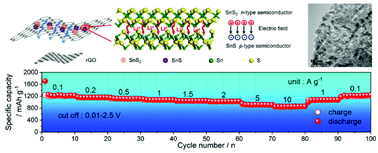SnS2–SnS pn hetero-junction bonded on graphene with boosted charge transfer for lithium storage†
Abstract
Despite the advantage of high capacity, practical implementation of the tin disulfide (SnS2) anode for lithium-ion batteries is still plagued by the inferior rate performance due to its low intrinsic electronic conductivity and mediocre ion transport in the bulk. Herein, to address these issues, a peculiar heterojunction of SnS2–SnS quantum dots (QDs) closely coupled with reduced graphene oxide (rGO) sheets was developed. Because of the typical n-type and p-type semiconductor characteristics of SnS2 and SnS, respectively, the formed pn junction at the SnS2/SnS interface will induce a built-in electric field, which can significantly accelerate lithium-ion transport through the SnS2/SnS interface. The ultrafine SnS2 and SnS nano-domains with superlong pn junction interfacial length construct an accelerated lithium-ion diffusion network, while the conductive rGO nanosheets provide a high-speed electron conduction pathway. Meanwhile, the flexible rGO chemically coupled with SnS2/SnS buffers the volumetric variation during repeated lithiation/delithiation processes and guarantees robust structural durability. These merits afford the designed SnS2–SnS/rGO electrode with fast electrode reaction kinetics and good structural durability upon cycling. Consequently, the delicate SnS2–SnS/rGO electrode harvests a superlative rate capability of 926 and 865 mA h g−1 at 5 and 10 A g−1, respectively, and excellent long-term cycling stability with a high reversible capacity of 1075 mA h g−1 at 1 A g−1 up to 1000 cycles with negligible degradation.



 Please wait while we load your content...
Please wait while we load your content...